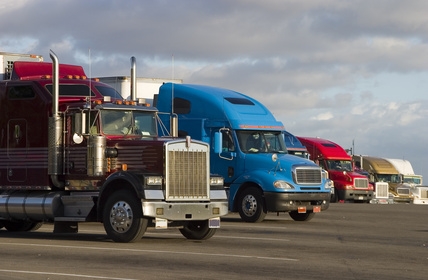
A preventive maintenance checklist is much like a pre-trip inspection. The Department of Transportation requires commercial truck drivers to preform a pre-trip inspection and enter it into their driver's log book. Because the preventive maintenance checklist is so familiar, it is easy to combine the two functions before each trip. Doing this will ensure your tractor-trailer stays on the highway.
Inspecting under the hood before each trip is imperative when it comes to preventative maintenance. Doing this will allow you to notice any possible problems early, and it may prevent costly repairs down the road. Items to check include the power steering fluid, motor oil, windshield washer fluid and coolant level. Closely inspect all hoses, looking for signs of wear, cracks or leaks. Physically check the tension on all belts and look for any signs of cracking or excessive wear. Inspect the entire engine for leaks, including the ground under the engine for any new fluid spots.
Inspecting the exterior of the tractor will not only help prevent costly repairs, but it may also prevent receiving a citation from the Department of Transportation (DOT). The DOT inspects the exterior of the tractor at truck scales and inspection sites. Turn on the headlights, running lights, turn signals and emergency flashers, and make sure no lenses are cracked or missing. Starting on the driver's side, look over the body of the tractor. Ensure the mirrors are secure and nothing is hanging from the body. Ensure all of the side marking lights and turn indicators are working properly. Inspect the front and rear tires and wheels, including the lug bolts. Look for any signs of cracks or abnormal wear on each wheel and tire. Inspect the springs, drive line and universal joints. If parked on a level surface, stand back and see if the truck is level; leaning to one side could be a sign of a worn or broken spring. Check the passenger side of the truck in the same manner as the driver's side. On the rear of the tractor, ensure the tail lights are working and no lenses are cracked. Physically check each mud flap to ensure it is mounted securely. Inspect both the hydraulic and air line that run from the tractor to the trailer. Look for any signs of cracks or abnormal wear. Inspect the exhaust. Ensure it is mounted securely. Also look for any signs of holes or cracks.
Begin the interior checklist by starting the engine. Listen for any knocking or any abnormal noises. Next, adjust the seat and test the seat belt. Ensure all mirrors are properly adjusted. Test the electrical devices, including the horn, windshield wipers and dashboard lights. Look at each dashboard instrument and ensure each one is within its normal operating readings. Next, test the air brakes. Repeatedly depress the brake pedal until the low-air-pressure buzzer sounds. Track the time that it takes for the pressure to reach an adequate level. Different systems have their own "normal" range. Ensure you are familiar with your air brake system.
There are many different types of commercial trailers, and each one has its unique features that need to be inspected. General maintenance checklist items include checking each tire and wheel. Inspect the air and hydraulic lines, looking for any signs of wear or cracks. Ensure each light is working properly. Check the mud flaps to ensure they are secure.